AMAZÔNIA EXPEDITIONS
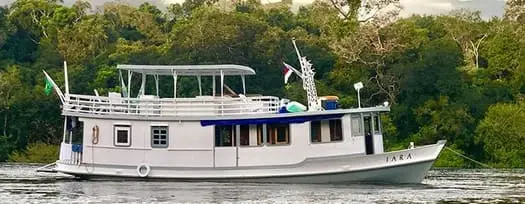


You decide how long do intend to stay and what to see, we take care of the rest.
Regular Cruises
| SENSES / BLISS | R$ 11.030 |
|---|
Departures
05>09 (Bliss)
03>10 (Bliss)
12>16 (Senses)
03>07 (Senses)
15>19 (Senses)
20>24 (Bliss)
26>30 (Bliss)
15>19 (Bliss)
Charter
| BOAT | 01->08 PEOPLE | 09->16 PEOPLE | 17->20 PEOPLE | |
|---|---|---|---|---|
| DORINHA | R$ 24.950 | R$ 26.330 | R$ 27.720 | |
| IRACEMA | R$ 25.640 | R$ 27.070 | R$ 28.490 | |
| Daily bilingual guides (NOT INCLUDED) range from R$ 250/día y R$ 500/día | ||||
Charter includes:
Voyage charter (crew & fuel for the cruise), full board and bilingual guide (guided excursions).
- Service on board with mineral water anytime all trip.
It does not include:
Travel insurance; Carriers; tips; phone calls; drink´s, beer and soft drinks will be charge according the consumption. And what more is not mentioned as included.
Embark/Disembark:
At Tropical Executive Hotel pier in Manaus. Embark at 10:00 AM.
IARA EXPERIENCE
| CRUISES | 01->02 PEOPLE | 03->04 PEOPLE |
|---|---|---|
| 3D/2N | R$ 17.768 | R$ 22.382 |
| 4D/3N | R$ 26.228 | R$ 33.149 |
| 5D/4N | R$ 34.688 | R$ 43.917 |
| 6D/5N | R$ 43.147 | R$ 54.683 |
What's included in Iara's packages?
- Cabins equipped with air conditioning and private bathrooms;
- One cabin with a double bed and a single upper bunk, and another with two single beds;
- Private expeditions with personalized itineraries;
- Pleasant indoor and outdoor areas for relaxation and enjoying nature while sailing;
- Full meals with non-alcoholic beverages included;
- Tour guides;
- Onboard service with unlimited mineral water throughout the trip.
Not included:
Guide; porters; tips; drinks are charged according to consumption. And anything not clearly indicated as included.
The Fleet
Comparative
| Boat | Dorinha | Iracema | Iara |
|---|---|---|---|
| Capacity (passengers) | 22 | 22 | 4 |
| Cabins | 11 | 11 | 2 |
| Lenght | 24,67 m | 26,29 m | 17,28 m |
| Weight | 6,10 m | 6,58 m | 4,27 m |
| Motor | 250HP MWM Diesel | 250HP MWM Diesel | 160HP MWM Diesel |
| Velocity | 8 nós | 8 nós | 7.8 nós |
| Decks | 3 | 3 | 2 |
The boats were designed to provide the greatest comfort and safety on your cruise, being a modern version of typical Amazon vessels. The Iracema and Dorinha boats have three spacious deck levels - Iara only 2, the upper one being a solarium, for better appreciation of the landscape.
The crew is made up of licensed sailors, chefs able to prepare the best of delicious Amazonian cuisine and trained helpers.
Each cabin is fully equipped with a private bathroom, central air conditioning, a double bed and a bunk bed, in addition to providing a wide view during the cruise!
Our 9m x 1.20m canoes are motorized using oars during observations and entry into the most difficult to access places.
We understand that a good boat trip is the best way to witness what the unrivaled biological diversity of the Amazon has to offer. To this end, we make the vessel available during the year round for ecotourism, scientific expeditions and meetings of nature lovers in general.
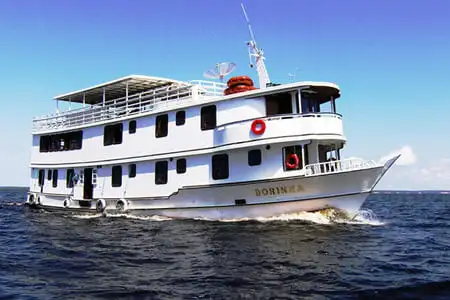
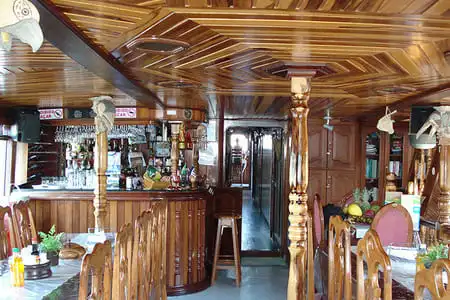
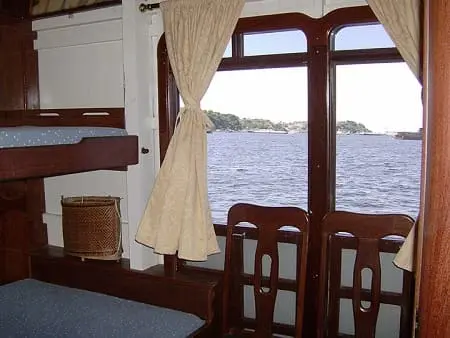
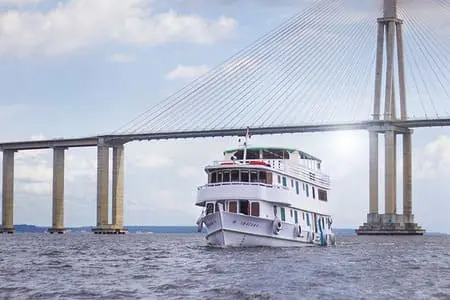
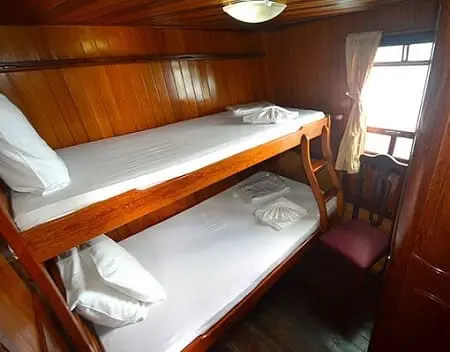

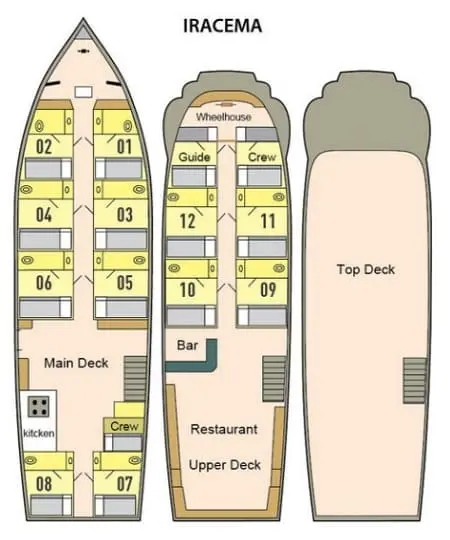
Main Deck - air-conditioned cabins (8) with private bathroom, bunk beds and reading lights. 6 cabins at the front and 2 at the back. Galery and entrance hall.
2nd. Deck - 4 air-conditioned cabins with private bathroom, bunk beds and reading lights. Bar / restaurant / conference room / Library. Wheelhouse.
Upper deck - Open deck for sunbathing, stargazing or observation. Barbecue grill.

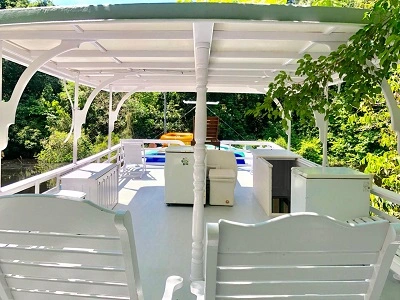
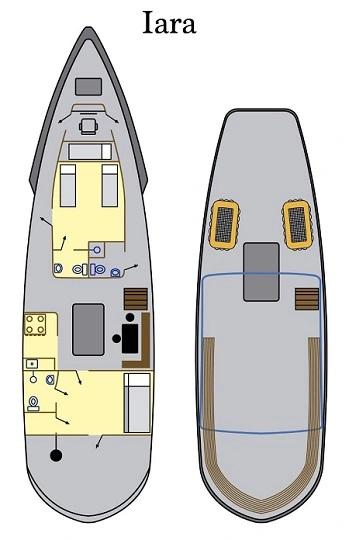
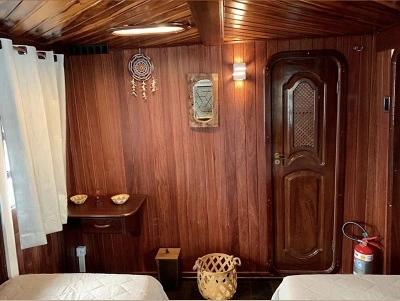
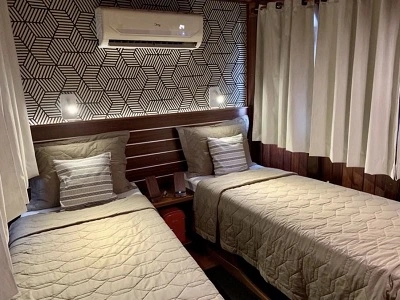

Main Deck - Entrance hall, bar, restaurant and kitchen, 2 air-conditioned cabins with private bathroom, bunk beds and reading lights, wheelhouse.
Upper deck
Open deck for sunbathing or stargazing. Barbecue grill.
Regular Cruises
In the market for over 40 years, navigating the Amazonian rivers, Amazônia Expeditions is known for designing river expeditions with itineraries
customized. Developing from the design of a simple itinerary, for those who visit the Amazon for the first time, as well as
expeditions demanding specific knowledge and including, for example, technical knowledge about botany, ornithology,
primatology and etc.
Visiting the Amazon is always a surprise, there is no such thing as bad weather, there are times when the rivers are at their
fullest and the
possibility of rain is greater and there are times when the rivers are less full, with the formation of beaches and trails before
submerged by the waters, in these periods the rains are not so common, but still a possibility, after all we are in the greatest
tropical rainforest in the world.
AMAZONIA BLISS EXPEDITION
From September to February (dry season)
Bliss is the feeling of true happiness, something we acquire after five days of expedition exploring river beaches, waterfalls, fountains of youth and local communities, where nature and culture meet mix through caves and rock formations, sandbanks and paths full of biodiversity.
DAY 1 - SAILING IS NECESSARY
Main activities: Interaction with dolphins / Exploration of the biodiversity found in the river region Ariaú / Night focus.
Bording at 10:00 am at Manaus port and start our journey with a safety briefing and presentation of the
crew and guests. Arriving at the boat takes a short walk, as the river will be drier and the boats will not
come so close to the port.
Our first glimpse of water is the dark waters of the Rio Negro, following through the Tatu Strait, we arrive at the region
known as Jacaré Ubal, where our journey through the Amazon begins and we have our first encounter with the one who owns
so many stories, legends and mysteries, the Boto, here we will see these animals also known as freshwater dolphins
interacting with visitors, an incredible opportunity for contemplation, interaction and photos.
We sailed for a few hours along the Negro River, contemplating the beauty of its surroundings, eyes and ears attentive to the possible
dates. In the Amazon, encounters with fauna and flora are always welcome, even if unscheduled, often at
nature surprises us. In the afternoon, we will take a motorized canoe trip along the Boca do Rio Ariaú for reconnaissance.
of the area and observation of the local fauna and flora, with the most trained eye of our guides, finding species hidden by the
leaves and trunks becomes an interesting challenge.
At the end of the day, when the moon is in a favorable position for our walk, we will make a new search for the wildlife that inhabits the
jungle and, at nightfall, the hiding place is given up to explore the paths of the forest, our eyes and focus are on those that during the day
we couldn't observe.
DAY 2 - ANAVILHANAS, LABYRINTHS AND ISLANDS
Main activities: Visit to the Anavilhanas archipelago / Chance to see the wire-tailed manakin / Visit to beaches and boat trip canoe.
It's morning in the Amazon, we wake up on that second day already inside the Anavilhanas archipelago, there are 400 islands that make up this
archipelago, paths that form labyrinths and make your visit an incredible discovery. With the dry period, the water mirrors
give way to sandbanks that form several beaches in the region, we have the opportunity to visit Lake Uruá for a
canoeing, observation and contemplation of the biodiversity found there, and, depending on the environment,
walk through one of the islands to look for a species of birds known as the Rabo de Arame, the curiosity of this bird is that
to attract the female, the males compete in a well-elaborated ritual dance, another natural spectacle found among
the trees of the Amazon.
We continue sailing in the afternoon, towards the Santo Antônio region, a region with a beautiful lake and dirt streams.
signature for further contemplation. It is incredible to observe the environmental differences in times of drought, even with that name, the rivers
magnificent buildings continue to give life to the forest, transforming previously flooded areas into beaches, floating houses on stilts and environments that
we spent months chasing them by canoe, now we walk through them.
In this area, we have the chance to observe amphibians of different colors, birds and some mammals, but when it comes to the forest, what
we find is always a bonus, but never a certainty. Jungle life is really just that, wild.
DAY 3 - WATERFALLS AND RAPIDS
Main activities: Visit to the rapids and waterfalls at Aturiá river / Camp during the day on the river known as the Fountain of Youth / Contemplation of local biodiversity.
We arrive at the Aturiá River, and a long day of contemplation and exchange with nature awaits us, we will change the balance of the waters of the
sailing by boat to camp on the banks of a remote rapids, a special environment for appreciating a
channel of extremely acidic waters, an interesting environment to observe since its combination of waters and forest bring
an ecosystem different from other regions. There are waterfalls and rapids that make the day away from the boat a refreshing one.
moment.
A curiosity is that this more acidic characteristic of the waters makes its color more reddish and the feeling that we leave
after a nice dive, we rejuvenate a few years.
Have we finally found the fountain of youth?
Opportunity to find in this region carnivorous plants, ornamental fish, often seen in so many aquariums, in their
natural environment, as well as birds such as maitacas and anacãs!
DAY 4 - MADADÁ AND CHAMELEON ISLAND
Main activities: Visit to Madadá, its rock formations and caves / Choose between canoeing and visit to the river beach / Contemplation of local biodiversity.
We continue our navigation through the dark waters of the Rio Negro, following along the other side, on the coast of Madadá. A region where
our walks offer a view of the rock formations, which are very similar to caves, provide incredible support to the
Amazon forest. The erosion process of thousands of years forms a unique scenario to be explored and a unique opportunity to visit
preserved forest.
In the afternoon, we travel through the channels of Ilha do Camaleão, where canoeing is available or we can just
enjoy a beautiful river beach bathed by black waters, exclusive to this dry period.
The night brings us the possibility of a dinner under the light of the stars, a unique spectacle to be contemplated, there is no sky
such as the one in the Anavilhanas region.
DAY 5 - INDIGENOUS COMMUNITY AND RETURN TO MANAUS
Main activities: Visit to the indigenous community / Welcome ritual by the community / Contemplation of the surroundings upon returning to Manaus.
We will sail the rivers on the way to Manaus, the return brings us the opportunity to contemplate and relax on our boat,
a chance to reflect on everything that has been experienced in these last few days.
Closer to Manaus, we will meet the indigenous tribe of Tatuyos for an incredible presentation, the tribe generously
shares with us its culture through stories combined with presentation rituals, the moment of sharing expected by
many and an exceptional listening and learning opportunity.
This community originally from the Cabeça do Cachorro region, northwest of the state of Amazonas, formed by at least 14
different indigenous ethnic groups, moved to near Manaus so that they could have better economic conditions of
subsistence and, also, to be able to present a little of their culture, so questions are welcome for those who wish to
learn more about this tribe.
We continue our return to the capital, arriving close to the city, we come across the meeting of the Negro and Solimões rivers,
opportunity to contemplate this very special phenomenon of rivers that run side by side, but do not mix.
Arrival in the city of Manaus will be at approximately 4 pm.
AMAZONIA SENSES EXPEDITION
From February to September (Flood Season)
Senses represents our five sharp senses after five days of close contact with nature, living the experience of life in an indigenous community, its culture, agriculture and handicraft, visiting lakes, streams and floating forests in the middle of the river, meeting amphibians, birds, primates, the sounds of the forest waking us up and accompanying us through the day until the night, the flavors of the fish, cassava flour, so unique and special. These five days are enough to bring the feeling to the heart that we know the real Amazon.
DAY 1 - START OF THE TRIP AND MEETING THE WATERS
Main activities: Visit to the Meeting of the Negro and Solimões Waters / Contemplation of riverside life along the rivers / Focusing of wildlife at night.
We board at 10:00 am in a port in Manaus and start our journey with a safety briefing and introduction of the crew and guests. The departure is through Manaus, capital of Amazonas, the Porto de Lenha as it was named so many years ago. We leave behind buildings, cars and the noises of the city, to navigate the rivers, the true roads for those who wish to truly know the Amazon. At first, the Rio Negro takes us to its meeting with the muddy Rio Solimões, a meeting that visually dazzles and enchants its visitors. visitors. The rivers that meet and don't mix are our first point of observation. We will sail the Solimões River in smaller canoes to facilitate our contemplation of local life. Between the engines and the inhabitants of the houses floating amidst the rivers, we follow the flow of the river, accompanied by the current that carries us to the Canal do Xiboreninha, moving us away of sounds and rumbles to embrace us with the sounds of the birds and monkeys that live there, a place so close to the big city and, yet so full of wildlife. We return to the vessel near sunset and, at night, we return to the Channel to observe the nightlife of the area with the focus made in canoes across the region. With the time of rest approaching, we will then continue on a night navigation west towards the village of Igarapé Preto, is approximately five hours of navigation.
DAY 2 - VILA DO IGARAPÉ PRETO AND JANAUACÁ
Main activities: Visit the Riverside Community, its plantations, rubber trees and flour production / Visit to the Enchanted Forest, the floating forest / Leisure options: canoeing or recreational fishing.
After five hours of navigation, we arrived at the place known as Igarapé Preto. The Vila is a fine example of the riverside lifestyle of the different communities that follow the banks of rivers and their tributaries. Life in an interior community in the Amazon adds to the agricultural production and the harvesting of typical fruits and grains, the production of cassava flour so highly regarded by the locals. With luck, we'll have the opportunity to witness this production, watch the harvest or even the planting of these fruits so characteristic of Brazil and Amazonas, such as Cocoa, Passion Fruit, Jenipapo, Urucum. In this area we also find rubber trees, tall trees that for so many years have provided latex for the production of rubber from their trunks. rubber, an item that brought so much prominence and wealth to the region in the past and was responsible for the last delineation of the states from Acre, Rondônia and Amapá who were also producers. An economic and cultural milestone. Our journey continues, now by canoe, crossing the community towards a place called Lago Encantado, an opportunity to observe a floating forest, unlike the igapós which are submerged forests very close to the rivers, here the trees actually float. A place of unique beauty, it offers a sample of Amazonian biodiversity in its prime, a demonstration of the force of nature that produces a floating forest formed mainly by aningas that mix with other species, water and debris that form a substrate capable of offering a base to other plants in a kind of organic raft with hydroponic culture. Trees such as the açaí tree, which typically grow on land and reach great heights, in this nutrient-rich environment, they grow and move with the coming and going of the boats, thus showing that they also float with the others. Words are not enough to demonstrate the natural greatness experienced there, and so susceptible to extinction. Preserving is necessary! We return for lunch and, at the end of the afternoon, we head to the region known as Janauacá, with options of activities divided between recreational fishing and bird watching and local life through the channels of the Mamory River. On this day, if we are lucky, we will meet a very beautiful bird typical of the region called Gypsy. At night, further into the Janauacá, at Ponta do Miuá, we will focus again to observe the wildlife of the region's fauna, around here we usually see sloths and other animals on our walks. We continue at night sailing towards the Ariaú River.
DAY 3 - BACK TO RIO NEGRO
Main activities: Interaction with the dolphins / Incursion through the channels of the Anavilhanas archipelago and contemplation of wildlife / Night Focus.
During the night, we sail along the Solimões River, passing in front of Manaus to continue along the Negro River towards the Ariaú River. after the breakfast, we will take a canoeing trip to observe the fauna characteristic of the area, lasting approximately 2 hours. The legend says that dolphins appear at night at riverside parties, but here we see them in the exclusive pink color of the Amazon accompanying the boats as local guides. Animals of unique beauty, freshwater dolphins are a special attraction to be seen in the region of Acajatuba. An excellent photographic record opportunity with the visit to the site. In the afternoon, already in the Três Bocas region, we continue sailing through the Anavilhanas archipelago, a group of 400 islands, and it is here that we will quietly explore the narrow and deep channels with our boat, our top deck transforms into an observation tower and contemplation. A moment to absorb everything that was experienced in those days of navigation, and we are still living, celebrating between macaws, toucans, parrots and with a perfect setting for a cocktail and Happy Hour, nothing like disconnecting from the hustle and bustle of everyday life and enjoying yourself reconnect with nature, the Amazon is your setting and, with your favorite drink in hand, what more could you want? The day isn't over yet! At night, we will look for new ways to contemplate the fauna and flora of the region, an opportunity to observe the life of the Amazonian jewel. which is the Anavilhanas archipelago. We continue our journey with night sailing down the Negro River and on to its tributary, the Cuieras River.
DAY 4 - CUIERAS REGION AND BARÉ COMMUNITY
Main activities: Visit the Baré community / Walk along a trail to Campina, chance of orchids and bromeliads. / Overnight in camp in the forest (optional).
We get up in the morning in the Cuieras region, we will take a walk to contemplate the wild life in the morning on the igarapé do Tucumã and then we will visit the Baré community called Nova Esperança, a community made up mainly of family members, from indigenous descendants, who make their art and crafts their way of life. They produce jewelry for their own use, home decor items carved in wood and feel excited to share their ideas and productions with visitors. In the afternoon, we go up the Cuieras River a little further towards Lake Jaradá, there we will do a small, simple and easily accessible trail. to get to know a unique micro ecosystem, the Campina. We started our walk in a forest that was higher and gradually lower, passing through the campinarana region, to finally reach the open countryside. In this place, it is possible to see orchids and bromeliads with flowers, if we are lucky, which makes our visit even more beautiful. We will walk back along the trail, to the shore of Lake Jaradá where we will have a special dinner, at the edge of the forest, at the Choupana in the side of the lake. For those who want the most complete experience, we offer sleeping hammocks in the straw house on the edge of the forest. Our night sailing is towards Manaus.
DAY 5 - RETURN TO MANAUS
Main activities: Visit to the indigenous community of Tatuyos / Welcome ritual / Contemplation of the surroundings when sailing back to Manaus.
We will continue our navigation back to Manaus. Around noon, we'll head to an indigenous tribe, the Tatuios, to an amazing performance, the tribe generously share their culture with us through stories combined with rituals of presentation, the moment of sharing expected by many and an exceptional listening and learning opportunity. This community originally from the Cabeça do Cachorro region, northwest of the state of Amazonas, formed by at least 14 different ethnic groups indigenous people moved near Manaus so that they could have better economic conditions of subsistence and, also, to can present a little of their culture, so questions are welcome for those who want to know more about this tribe. This is how we end our 5th day of the expedition, certain that we know more about the Amazon, we learn about its culture, history and people, we saw, heard and felt what it truly means to be one with the Amazon and why Amazoniar is necessary. We arrived in Manaus around 16:00.